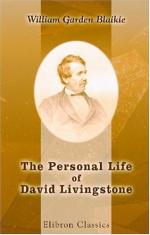One of his first endeavors after reaching Tette was to ascertain how far the navigation of the Zambesi was impeded by the rapids at Kebrabasa, between twenty and thirty miles above Tette, which he had heard of but not seen on his journey from Linyanti to Quilimane. The distance was short and the enterprise apparently easy, but in reality it presented such difficulties as only his dogged perseverance could have overcome. After he had been twice at the rapids, and when he believed he had seen the whole, he accidentally learned, after a day’s march on the way home, that there was another rapid which he had not yet seen. Determined to see all, he returned, with Dr. Kirk and four Makololo, and it was on this occasion that his followers, showing the blisters on their feet burst by the hot rocks, told him, when he urged them to make another effort, that hitherto they had always believed he had a heart, but now they saw he had none, and wondered if he were mad. Leaving them, he and Dr. Kirk pushed on alone; but their boots and clothes were destroyed; in three hours they made but a mile. Next day, however, they gained their point and saw the rapid. It was plain to Dr. Livingstone that had he taken this route in 1856, instead of through the level Shidina country, he must have perished. The party were of opinion that when the river was in full flood the rapids might be navigated, and this opinion was confirmed on a subsequent visit paid by Mr. Charles Livingstone and Mr. Baines during the rainy season. But the “Ma-Robert” with its single engine had not power to make way. It was resolved to apply to Her Majesty’s Government for a more suitable vessel to carry them up the country, stores and all. Until the answer should come to this application, Dr. Livingstone could not return with his Makololo to their own country.
While making this application, he was preparing another string for his bow. He wrote to his friend Mr. James Young that if Government refused he would get a vessel at his own expense, and in a succession of letters authorized him to spend L2000 of his own money in the purchase of a suitable ship. Eventually, both suggestions were carried into effect. The Government gave the “Pioneer” for the navigation of the Zambesi and lower Shire; Livingstone procured the “Lady Nyassa” for the Lake (where, however, she never floated), but the cost was more than L6000—the greater part, indeed, of the profits of his book.
The “Ma-Robert,” which had promised so well at first, now turned out a great disappointment. Her consumption of fuel was enormous; her furnace had to be lighted hours before the steam was serviceable; she snorted so horribly that they called her “The Asthmatic,” and after all she made so little progress that canoes could easily pass her. Having taken much interest in the purchase of the vessel, and thought he was getting a great bargain because its owner professed to do so much through “love of the cause,” Livingstone was greatly mortified when he found he had got an inferior and unworthy article; and many a joke he made, as well as remarks of a more serious kind, in connection with the manner which the “eminent shipbuilder” had taken to show his love.




